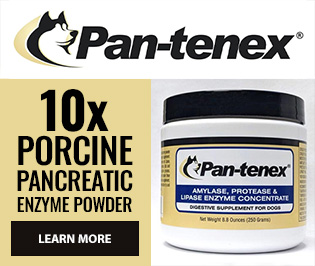Digestive enzymes work best when they’re mixed into your dog’s food the right way. Whether you’re just starting or fine-tuning your routine, understanding how to mix enzyme powder properly can make a big difference in results. This guide walks you through the best method step by step.
Why Mixing Matters
Enzyme powder supports your dog’s digestion by helping break down food before it reaches the stomach. When added correctly, enzymes begin this process right in the bowl. But if enzymes aren’t mixed and activated properly, they may not be as effective, especially for dogs with compromised digestion.
Pan-tenex is a high-potency porcine enzyme powder trusted by thousands of dog owners. It’s designed to be mixed into each meal to support nutrient absorption and digestive comfort.
Step-by-Step Mixing Instructions
- Prepare the Meal: Portion out your dog’s regular food as you normally would. This can be kibble, home-cooked, or raw (raw food should be minced).
- Moisten the Food: Add a splash of water (room temperature or lukewarm) to slightly moisten dry food. This helps the enzyme powder stick and begin working. Don’t use hot water, as heat may damage enzyme activity.
- Add Enzyme Powder: Sprinkle the correct amount of enzyme powder onto the moistened food. Use the recommended serving size based on the product label. If using Pan-tenex, see our feeding guidelines.
- Mix Thoroughly: Stir the food and powder together until it’s evenly distributed throughout the meal. You want a homogenous mixture of enzymes to food so the composition is uniform.
- Let Sit Before Serving: Allow the prepared food with enzymes to sit (incubate) for 15 to 20 minutes at room temperature. This activation time gives the enzymes a head start in breaking down the food.
Tips for Picky Dogs
If your dog is hesitant to eat enzyme-mixed food, try adding a splash of broth, a bit of canned pumpkin (plain), or a spoonful of something they really enjoy. Be sure to avoid anything with sugar, dairy, or artificial flavors. Many picky eaters warm up to the new routine after just a few meals once they start feeling better. Feeding meals on a flat plate can also help some dogs. Avoid using plastic bowls that can retain odors & bacteria. Use stainless steel bowls if possible.
How to Track Changes
You may start noticing firmer stool, better appetite, or reduced gas in just a few days. For better clarity, use the Dog Enzyme Digestive Health Stool Tracker to document improvements in your dog’s digestion.
Final Thoughts
Taking the time to properly mix enzyme powder with your dog’s food ensures you’re giving them the best support possible. A small change in routine can lead to a big change in comfort, digestion, and overall well-being. Always consult with your veterinarian before giving any supplements to your dog.
If you have more questions about enzyme use, feeding tips, or dosage guidance, feel free to contact us or explore our other help articles.

